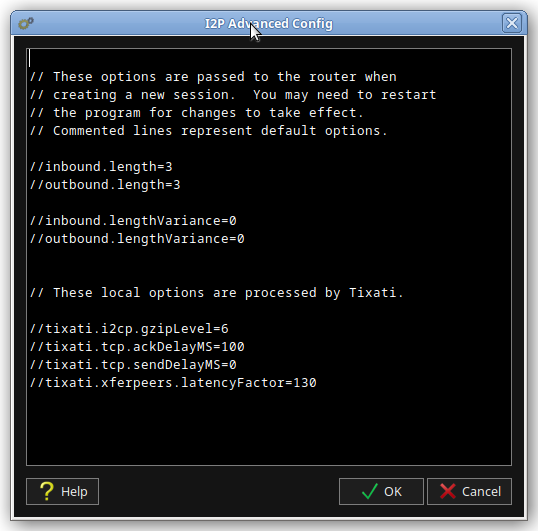This dialog is launched from Settings > I2P.
Most options that aren't used locally are forwarded to the I2P router during session setup. To reset your session and apply changes immediately, either restart Tixati or simply toggle the I2P feature off for a few seconds and then back on.
I2P router parameters are fully documented in the
I2P docs.
inbound.length
outbound.length
These options control the number of I2P routers between the local endpoint and any remote endpoints. A lower number might bring higher speeds, but is less secure against a malicious router learning the true IP address of your endpoint. The default value is 3.
inbound.lengthVariance
outbound.lengthVariance
This will add a random amount to the tunnel length for every new session. The default value is 0.
inbound.quantity
outbound.quantity
The number of tunnels to keep open for incoming and outgoing traffic. The default value is 5.
i2cp.gzipLevel
This controls the gzip compression level on outgoing I2CP messages. Even under heavy traffic, the compression will use very little CPU, so it is not recommended to change this unless you are using a very low-powered device. The default is 6.
tcp.ackDelayMS
This is related to the streaming protocol, and controls the amount of time to wait, in milliseconds, before sending an acknowledgement message. This helps to save a little bit of return bandwidth, but can result in less accurate RTT estimation and send window control on the remote side, which can slow down the connection in some situations. The default is 100.
tcp.sendDelayMS
This is related to the streaming protocol, and controls the amount of milliseconds to wait after the send buffer gets an initial bit of data, before actually assembling messages and starting to transmit. This is sometimes referred to as the Nagle algorithm. Depending on the protocol layered above, it can help reduce overhead due to having fewer messages with larger payloads. In the case of torrents, this doesn't seem to make a difference aside from adding some latency. The default is 0.
xferpeers.latencyFactor
This will make I2P peers in transfers have a larger block request pipeline than regular peers. This is needed due to the high round trip times between I2P peers. The pipeline length in regular internet peers is approximately 2.5 seconds on average. This option is specified in percent, so 100 is equal to the regular peer, and 130, the default, is a modest increase.

